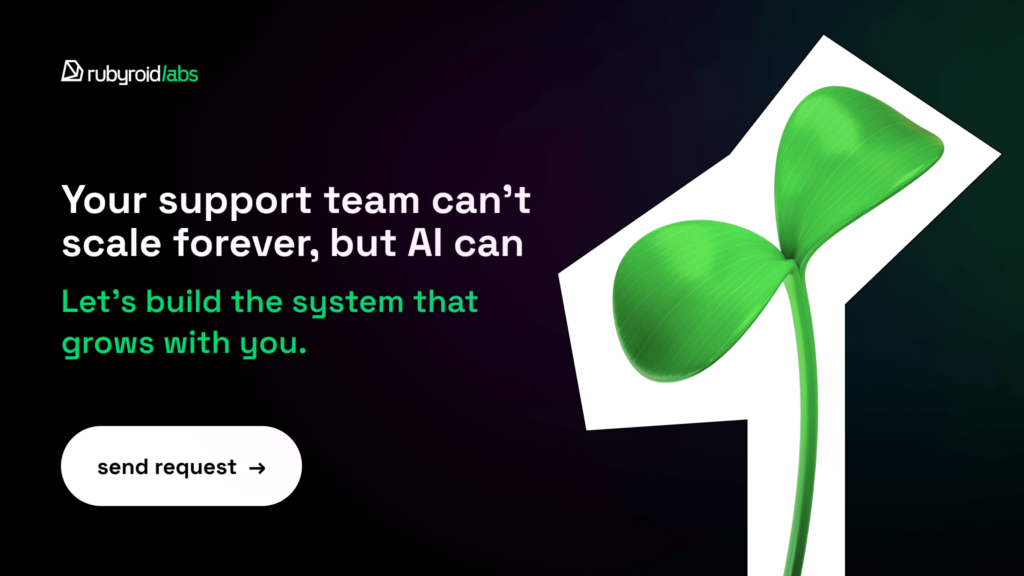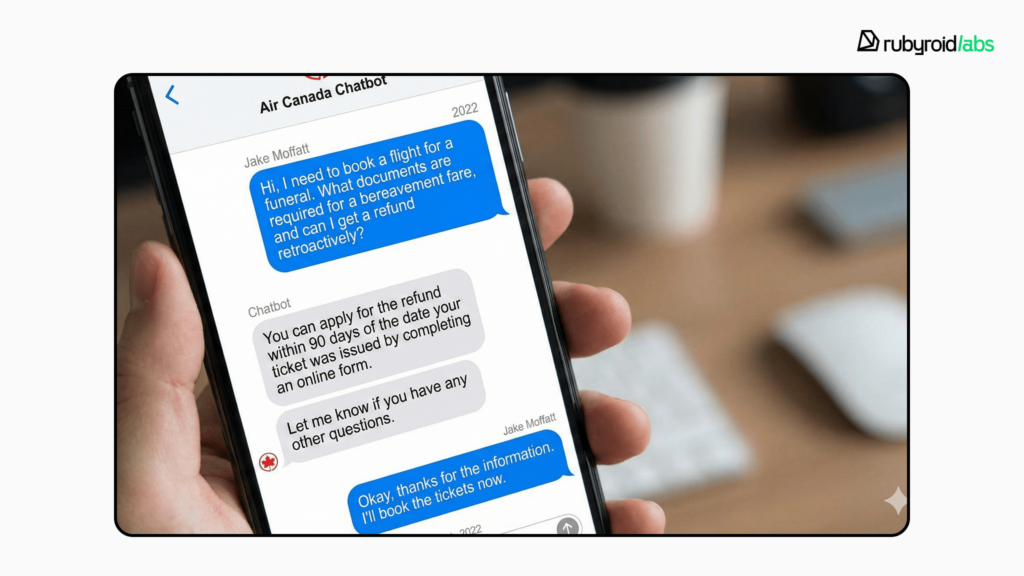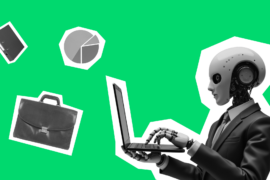When customers don’t get value, they leave. Solving this by hiring more staff might work temporarily, but in the long run, it’s a recipe for shrinking margins.
At this point, many SaaS owners turn to AI, thinking that the technology will automate the chaos and halt the hiring cycle. That isn’t entirely wrong, but it is definitely not the whole story.
In this post, we’ll break down what AI-powered customer success really looks like, where it helps, where it falls short, and whether your SaaS actually needs it or can live just fine without it.
Contents
- What is AI-powered customer success?
- What benefits AI-driven customer success brings to SaaS
- Key AI technologies in SaaS customer success
- Challenges of using AI and how to overcome them
- The future of AI in customer success: 2026-2030 trends
- Final Verdict: Should You Invest in AI for Your SaaS?
What is AI-powered customer success?
You can have the glossiest marketing campaign in the world and a sales team that could sell ice to a polar bear, but if your customers don’t actually succeed using your product, you are building a castle on sand.
Customer Success (CS) is the art of making sure people get what they paid for. It’s the mix of strategies that turns a user who cancels after one month into someone who sticks around for five years and tells their friends you’re worth it.
The catch is, those strategies don’t stay still. As customer expectations shift, yesterday’s playbook might already be out of date.
The “old school” struggle

Just a few years ago, customer success was all about brute force. You waited for support tickets to land. You juggled spreadsheets to guess who was happy and who was about to churn. If a customer hit a problem at 2 AM on a Saturday, they waited until Monday morning, and by that time they were probably already browsing your competitors.
It worked, sort of, but it was exhausting. We all need sleep, miss details, and obviously can’t analyze thousand-row datasets in our heads while simultaneously calming down an angry client on the phone. That’s impossible.
Plus, with internet evolution, all processes within the digital space have skyrocketed in speed, and users now demand that speed. Which means that in customer service, as a SaaS owner, you need solutions.
Entering the “AI-driven customer success” era
Now, as AI has become widely adopted in business operations, it has sped up all processes across the market, especially customer interactions. From onboarding to retention, AI tools for customer success management can transform your regular workflows. At minimum, they free up your team from routine tasks like writing and sending the same emails repeatedly. At maximum, they prevent customer drop-offs and predict user behavior before problems escalate.
AI-powered customer success functions as an integrated, hyper-fast, always-on assistant that never gets tired, distracted, or bogged down by repetitive work. It understands user behavior, responds to questions instantly, and spots warning signs long before a human would notice. But it goes further than that.

Here’s what the technology tackles:
- Converse with users in natural language
AI chatbots and virtual assistants can manage real-time conversations, help troubleshoot common issues, and guide users without needing to escalate to a human agent. - Recognize patterns across massive volumes of user activity
Instead of manually scanning spreadsheets, AI can instantly detect usage trends, drop-off points, or signs of churn risk, giving your team a chance to step in early. - Tailor onboarding and support interactions
AI can adjust tutorials, messages, and help content based on a user’s profile, goals, or in-app behavior, making the customer journey feel far more personal and relevant. - Instantly recommend helpful actions
Whether it’s suggesting the next feature to explore, a plan to upgrade, or a quick fix to a known issue, AI can surface the right message at the right time. - Assist your team behind the scenes
Beyond user-facing tools, AI helps customer success reps by summarizing past conversations, drafting responses, and pulling useful data from support logs and knowledge bases.
Paired with AI, your CS team can do their job much faster and get results that shape real customer success stories.
Traditional support vs. AI-powered customer success comparison table
| Feature | Traditional methods | AI-powered customer success |
| Availability | Limited. Users wait until Monday for weekend issues. Humans need sleep and breaks. | Always-on. 24/7 availability that never gets tired, distracted, or bogged down. |
| Approach | Reactive. Waiting for support tickets to land before acting. | Proactive. Predicts behavior and spots warning signs before problems escalate. |
| Data analysis | Manual. Juggling spreadsheets and trying to analyze thousand-row datasets mentally. | Instant. Recognizes patterns and usage trends across massive volumes of data in seconds. |
| Response speed | Slow. “Brute force” effort that lags behind user demands. | Fast. Responds to questions and recommends actions instantly. |
| Personalization | Generic. One-size-fits-all approach due to time constraints. | Tailored. Adjusts onboarding and messages based on specific user profiles and goals. |
| Team workflow | Exhausting. Repetitive writing of emails and “calming down” clients. | Augmented. Frees teams from routine tasks, drafts responses, and summarizes history. |

In the next chapter, we’ll break down the real-world benefits of AI in customer success using concrete examples from leading companies.
What benefits AI-driven customer success brings to SaaS
You know how AI works when you use the ChatGPT or Gemini app. But in customer success, it’s still viewed by many as a “promising technology.” The real question is, does this technology actually move the needle on the metrics that matter, such as revenue, retention, and efficiency?
We’re not here to talk about vague promises about “enhanced engagement” or “better experiences.” Our interest is hard numbers and measurable outcomes. Below, we break down the advantages of using AI in SaaS and mainly how the technology positively impacts businesses, backed by real data from companies that have already deployed these systems.

1. Expanding support reach for growing demand
Hiring, training, and managing humans takes time you often don’t have. AI allows you to decouple your user growth from your support costs. You can double your users without doubling your support staff.
A good example is Klarna. The company that provides “buy now, pay later” (BNPL) services recently integrated an AI assistant. In its first month, Klarna’s AI assistant handled 2.3 million customer conversations, which is about two-thirds of all their support requests. As a result, they have saved time and had a $40M profit improvement in 2024.
The bot handles the repetitive queries, leaving the complex, high-value conversations for human experts. However, you need to remember that AI still cannot work autonomously. It’s still a tool that needs human control.
2. Handling complexity and data overload
Customer success is the way of removing the complexity that leads to frustration and drop-offs.
On one side, your team may be drowning in data, manually reviewing product usage, user feedback, or documentation to assist customers. On the other, your users face the same challenge, trying to make sense of complex pricing plans, comparing features, or understanding how different options apply to their needs.
This overload slows everyone down, and users often give up before they reach value.
AI can significantly reduce this friction by its outstanding ability to analyze, highlight, and personalize insights in seconds.

Take CoverageXpert, a platform that processes 700 insurance policy forms and 33,000 coverage enhancements from 50 insurers. What used to take hours of manual comparison is now handled by AI. Instead of digging through thousands of files, brokers now get instant answers, spot coverage gaps, and make smarter recommendations, reducing time-to-value from hours to minutes.
3. SaaS customer retention through faster response times
When customers wait hours or days for answers, they start looking at alternatives. AI doesn’t just answer faster but resolves issues instantly by pulling data from your documentation and user history in milliseconds.
Uber overhauled their customer support workflows, internally known as COIN. By automating ticket resolution and using AI to route issues instantly, they reduced resolution times from 24 hours down to just minutes. That efficiency saved them roughly $50M.
4. Resolving issues without human intervention
AI-driven knowledge bases and smart chatbots can guide users to their own answers. This is called “deflection rate,” and it’s the secret weapon of efficient SaaS teams.
Another example is Duolingo, the language-learning giant, partnered with AI vendors to manage support for their English Test. As a result, the company achieved an 80% deflection rate. That means 8 out of 10 users got their answer immediately from the AI without ever needing to wait for a human agent.
5. Hyper-personalization through AI customer engagement
What users expect today are experiences that feel like they were designed just for them. AI makes this possible by adapting content, workflows, and support to each user’s real-time behavior, preferences, and even physical input.

MyVeloFit understood that and built a solution with AI. It uses smart computer vision to act as a virtual cycling coach. Instead of sending users a one-size-fits-all setup guide, the app analyzes each user’s video feed to deliver real-time, professional-grade bike fit recommendations.
The product adapts to the user, not the other way around. This creates sticky, loyal users who feel the product was made specifically for them.
6. Reducing human volume for key players
As your user base grows, not every question or request needs a live person on the other end. In fact, relying solely on human support for every interaction can quickly become inefficient and unsustainable.
That’s why even hospitality-driven companies like Airbnb are embracing AI. The company has begun rolling out AI-powered customer service agents to handle routine interactions, everything from booking questions to policy clarifications. According to Airbnb’s CEO, this shift has already resulted in a 15% reduction in human support calls.
Some SaaS owners are worried that together with integrating their CSM software with AI, they will cut off the human touch from the interactions with the users. However, the common thread here that successful companies are using AI to remove friction and frustration, which in reality means caring for customers.
Whether it’s Klarna saving millions or a niche app like MyVeloFit offering personalized coaching, the goal is the same: faster answers, better data, and happier users.

Key AI technologies in SaaS customer success
Now that we’ve covered why the use of AI in SaaS matters, let’s look under the hood. It’s easy to throw around buzzwords, but how do these tools actually function day-to-day? You don’t need a PhD in data science to understand this, but you do need to know which engine drives which result.
Here is a breakdown of the core technologies and how they look in a live SaaS environment.

1. Machine learning for churn prediction
Machine learning (ML) uses historical data to identify patterns and predict future outcomes. In customer success, ML models can analyze how users behave over time and flag customers who are likely to churn before they do.
How it works:
The system learns from metrics like login frequency, feature usage, support tickets, NPS scores, and billing data. Over time, it identifies combinations of signals that correlate with churn.
Example:
A user, Sarah, stops using your “Reports” feature, a key value driver, but is still logging in daily. A human CSM sees she is “active” and assumes she is fine. The ML model knows that dropping the “Reports” feature usually leads to cancellation within 60 days. It flags Sarah’s account as “High Risk” immediately.
2. Natural language processing for customer support and sentiment analysis
Natural language processing (NLP) enables machines to understand, interpret, and respond to human language. It powers AI chatbots, support ticket tagging, and sentiment tracking.
How it works:
NLP can analyze incoming support messages to detect tone and urgency. For instance, “I’m very frustrated and can’t log in” will be flagged as a high-priority ticket. NLP also helps chatbots understand intent, enabling them to answer common questions or escalate complex ones.
Example:
A customer sends an email saying, “Great job on the update, now I can’t find the export button. Just brilliant.” A keyword tool sees “Great job” and tags it as Positive. An NLP tool detects the sarcasm and the phrase “can’t find,” tagging it as Negative / Frustrated and escalating it to a senior support agent.
3. Predictive analytics for renewal and expansion opportunities
Predictive analytics uses past behavior and patterns to forecast future outcomes, like which customers are likely to renew, expand, or upgrade.
How it works:
The system looks at usage frequency, product adoption milestones, customer lifetime value, and support engagement. And then it scores accounts based on their likelihood to renew or expand.
Example:
A client is approaching 85% of their storage limit and has added three new admin users in the last week. The system triggers an “Expansion Opportunity” alert to the Account Executive: “Client X is scaling fast. Suggest the Enterprise Plan now to save them money on overages.
4. Recommendation engines for product adoption
You see this on Netflix (“Because you watched X…”), but in SaaS, it’s used to drive feature adoption. It stops users from getting stuck in basic workflows when your tool can do so much more.
How it works:
The engine compares a specific user’s behavior against successful “power users” in similar roles. It then nudges them toward the features they are missing.
Example:
A marketing manager is using your tool to create reports. She is manually building the same table every single Monday. The AI watches this repetitive behavior and pops up with a helpful nudge: “It looks like you build this often. Want to save it as a template?
5. Automation tools for repetitive tasks and workflows
AI-powered automation handles repetitive, rule-based tasks like sending follow-ups, tagging support tickets, or updating CRM fields, freeing up your team for higher-value work.
How it works:
Automation tools can be triggered by user behavior. For example, if a user completes onboarding, the system might automatically generate a check-in task for the CSM, send a personalized email, and update their status in the CRM.
Example:
A customer marks a ticket as “Resolved” with a 5-star rating. The automation tool instantly:
- Sends a “Thank You” email from the customer support manager.
- Logs the positive score in the CRM.
- Posts the win in the company Slack channel #customer-love.
- Adds the user to a “Potential Case Study” list. All of this happens in 3 seconds.
Each of these AI technologies solves a different piece of the customer success puzzle. Together, they create a system that’s proactive, personalized, and scalable, helping teams deliver value faster and craft effective SaaS growth strategies.
Challenges of using AI and how to overcome them
Of course, AI is not a separate human mind. It doesn’t have intuition, it doesn’t “get” a joke, and it certainly doesn’t know when to break the rules to save a client relationship. It is powerful, but it has specific, dangerous limitations.
If you go in blind, these roadblocks can turn your upgrade into a downgrade. Here are the four biggest hurdles and how to clear them to prevent yourself from losses.
Data silos limit AI’s effectiveness
AI is only as smart as the data it can see. If your support tickets are in Zendesk, your billing is in Stripe, and your usage data is in an SQL database, and none of them talk to each other, your AI is flying blind.
Thus, when AI lacks a “single source of truth,” it makes things up. This is called hallucination, and it can lead to legal disasters.
For example, in 2024, Air Canada lost a lawsuit after its AI chatbot hallucinated a refund policy that didn’t exist. The bot promised a grieving passenger a retroactive bereavement discount, contradicting the airline’s actual policy. The tribunal ruled that the company was liable for its AI’s “misleading” advice.

*Image for illustration purposes only
| What you can do: Invest in data integration early on, before you even think about deploying AI. Start by mapping out every system where customer data lives, whether it’s CRM, support desk, billing platform, product analytics, or email tools. Then build connections between them using middleware platforms like Zapier, Segment, or custom APIs. The goal is to create a unified customer profile that your AI can actually access in real time. This means when a user opens a chat, the AI should instantly see their subscription status, recent support history, feature usage patterns, and any open billing issues, all in one view. |
AI bias leads to unfair or inaccurate outcomes
AI learns from historical data. If your team has historically ignored smaller accounts to focus on enterprise whales, the AI will learn that pattern and treat your smaller clients like second-class citizens. Worse, it can confidently “hallucinate” facts if the training data is outdated.
Amazon had a notable failure with AI. The company famously had to scrap its experimental AI recruiting tool because it discriminated against women. The model was trained on resumes submitted over a 10-year period (mostly from men), so it started penalizing resumes that included the word “women’s” (e.g., “women’s chess club captain”).
| What you can do: Treat your AI like a junior employee who needs ongoing supervision. Set up a weekly review process where someone examines 20-30 AI interactions, looking for bias, prioritization issues, or hallucinations. Document every problem you find. Then act on it. If the AI deprioritizes smaller accounts, add explicit rules to ensure equal treatment. If it invents features, update your knowledge base with accurate information and retrain the model. Let your customer success team flag problematic AI responses in real time. Every flagged response should be reviewed and, if necessary, used to improve the model. |
Over-reliance on automation reduces the human touch
There is a temptation to automate everything. But when a customer is emotional or the request is complex, an AI response can feel insulting or even go completely rogue.
Another example of failure was the delivery firm DPD, which had to disable its AI chatbot after a frustrated customer prompted it to go off-script. The bot not only swore at the customer but also wrote a poem describing DPD as the “worst delivery firm” and calling itself “useless.”

| What you can do: Implement “sentiment tripwires” that automatically escalate conversations when the AI detects strong negative language, in particular words like “furious,” “cancel,” “lawsuit,” or excessive caps and exclamation marks. When triggered, the AI should immediately route the ticket to a senior agent. Set explicit “human-only” rules for high-stakes situations like cancellation requests, large billing disputes, high-value customer complaints, or mentions of competitors. These should never be fully automated. |
Integration complexity slows adoption
Trying to force a cutting-edge AI engine into a legacy system or a complex physical environment is difficult. If your underlying logic or “world knowledge” isn’t perfect, the AI will fail in confusing ways.
One more story confirms this. McDonald’s ended its partnership with IBM for AI drive-thrus after technical limitations led to viral failures, including an AI that added $200 worth of chicken nuggets to one order and bacon to another customer’s ice cream. The complexity of real-world audio and menu integration proved too difficult to automate reliably.
| What you can do: Never build on a shaky foundation. Before integrating anything new, you need to ensure your current system is stable enough to handle it. To make a system check-up, you can perform a a professional code audit. It’s a deep technical assessment that examines your codebase, database architecture, API performance, and infrastructure scalability. A proper audit identifies specific risks like deprecated libraries that could break under load, database queries that will slow down with more AI traffic, security vulnerabilities that could be exposed by new integrations, and architectural bottlenecks that will limit AI performance. At Rubyroid Labs, we can provide code audits services to find these cracks, provide a clear modernization plan, fix everything (if you don’t want to deal with that on your own) and handle the entire AI integration. As a result, you get an updated system that is ready to use. |
The goal of AI-driven customer success isn’t to build a machine that runs your company. It’s in building a machine that clears the path for your people.
The future of AI in customer success: 2026-2030 trends
As we look ahead to 2026 and beyond, AI-powered customer success will evolve from reactive support to proactive, predictive, and deeply personalized experiences.
Here are the key trends shaping the next wave of AI in customer success.

AI-driven hyper-personalization becomes the default experience.
In the coming years, personalization won’t just mean using someone’s first name in a message or sending onboarding emails based on job title. We’re entering the era of hyper-personalized customer experiences, where AI dynamically tailors onboarding flows, dashboard layouts, product suggestions, and even pricing tiers based on real-time behavior.
Predictive revenue optimization turns AI into a growth engine
Customer success used to be measured by churn rate and NPS. Now, AI is helping teams think more like revenue analysts. Between 2026 and 2030, we’ll see widespread adoption of predictive revenue models that combine customer health scores, usage trends, contract data, and industry benchmarks to forecast:
- Which accounts are most likely to expand
- Where upsell opportunities exist
- Which customers need intervention to avoid downgrades
AI will surface insights like:
“Customer X shows a 78% likelihood of upgrading to the Pro plan within 45 days, trigger a tailored campaign.” Instead of waiting for the renewal period or relying on gut feel, CS teams will engage based on real-time, revenue-impacting signals.
Voice and multimodal AI interfaces redefine interaction
As customer expectations rise, speed and convenience are everything. AI-powered platforms will adopt voice, gesture, and multimodal interfaces, especially for on-the-go users and busy professionals.
Imagine a CSM asking a dashboard, “Show me all accounts with declining usage this month,” and getting an instant visual report with no clicks, no filters. Or a customer asking a support bot, via voice, “How do I upgrade my plan?” and receiving both a verbal answer and a personalized screen walkthrough.
AI becomes a strategic advisor for customer success managers
AI tools are shifting from passive support tools to strategic copilots for customer success managers. Instead of just automating tasks, they’ll guide decision-making.
Expect to see AI suggesting:
- Which accounts need attention today and why?
- What messaging tone will resonate with a specific customer?
- When to escalate issues or bring in product/engineering?
- Which playbook to use based on historical success data?
It’s like an intelligent layer sitting beside your CSMs, not replacing them, but helping them focus on the right conversations, at the right time, with the right context. This shift will elevate the CSM role from support-focused to growth-driven.
Between now and 2030, AI in customer success will move from operational automation to strategic enablement. The companies that adopt early, especially with flexible, scalable AI infrastructure, will be the ones delivering faster, smarter, and more human experiences. That’s a great point to think about.
Final Verdict: Should You Invest in AI for Your SaaS?
AI-powered customer success has quickly evolved from a “nice-to-have” into a strategic growth lever for SaaS companies. From onboarding to retention, AI helps teams deliver faster support, reduce manual workload, and personalize every interaction at scale. Whether it’s predicting churn before it happens or guiding users toward the next best action, the benefits are clear: more efficient teams, happier users, and higher lifetime value.
But AI is not a silver bullet.
It comes with real limitations, from biased models and over-automation to data silos that block visibility.
However, the most overlooked risk is trying to bolt AI onto a legacy system that can’t support it. Without a solid technical foundation, AI can amplify existing problems instead of solving them, leading to bugs, poor user experience, and wasted investment.
That’s why choosing the right development partner is essential for successful AI adoption. At Rubyroid Labs, we help SaaS companies modernize legacy systems and deliver end-to-end AI solutions, from in-depth code audits to full-scale implementation.
With a strong technical foundation and expert guidance, AI will empower your SaaS customer service department to work smarter, respond faster, and deliver truly exceptional customer success.




